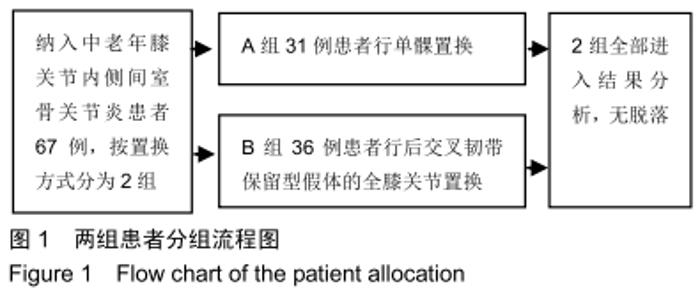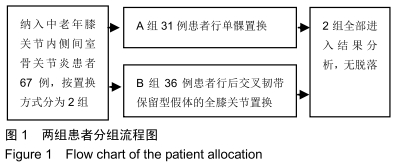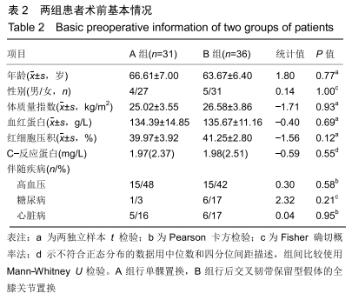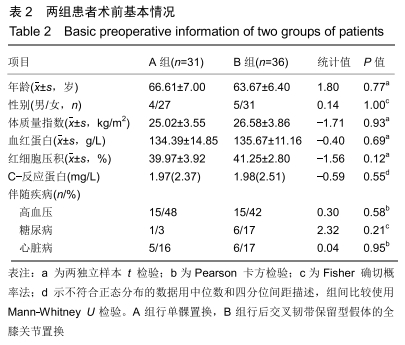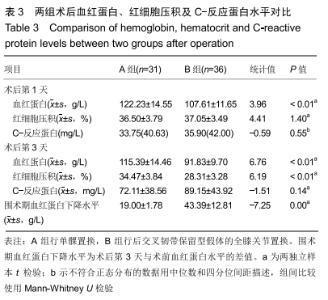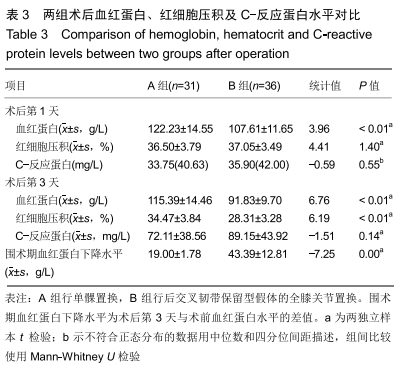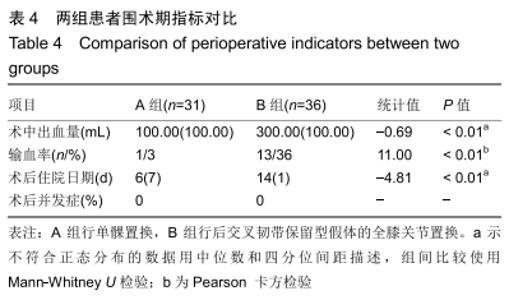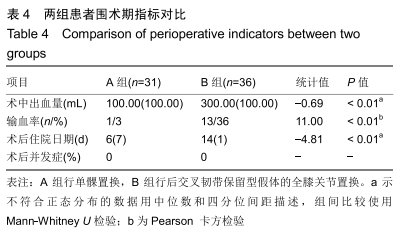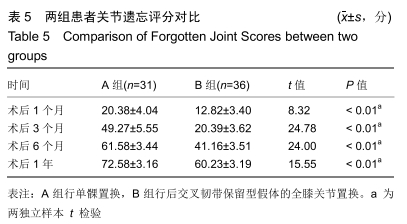Chinese Journal of Tissue Engineering Research ›› 2020, Vol. 24 ›› Issue (15): 2329-2334.doi: 10.3969/j.issn.2095-4344.2602
Previous Articles Next Articles
Comparison of short-term outcomes between unicompartmental knee arthroplasty and posterior cruciate ligament-retaining total knee arthroplasty
Han Mengguang, Qi Yusen, Han Zhen, Tian Weichao, Zhang Xingxu, Yang Yang
- Department of Joint Surgery, Affiliated Hospital of Chengde Medical College, Chengde 067000, Hebei Province, China
-
Received:2019-08-26Revised:2019-08-27Accepted:2019-10-25Online:2020-05-28Published:2020-03-22 -
About author:Han Mengguang, Master candidate, Physician, Department of Joint Surgery, Affiliated Hospital of Chengde Medical College, Chengde 067000, Hebei Province, China
CLC Number:
Cite this article
Han Mengguang, Qi Yusen, Han Zhen, Tian Weichao, Zhang Xingxu, Yang Yang . Comparison of short-term outcomes between unicompartmental knee arthroplasty and posterior cruciate ligament-retaining total knee arthroplasty[J]. Chinese Journal of Tissue Engineering Research, 2020, 24(15): 2329-2334.
share this article
| [1] DE VROEY H, STAES F, WEYGERS I, et al. Hip and knee kinematics of the forward lunge one year after unicondylar and total knee arthroplasty. J Electromyogr Kinesiol. 2019; 48:24-30. [2] LIM JW, COUSINS GR, CLIFT BA, et al. Oxford unicompartmental knee arthroplasty versus age and gender matched total knee arthroplasty - functional outcome and survivorship analysis. J Arthroplasty. 2014; 29(9): 1779-1783. [3] LYONS MC, MACDONALD SJ, SOMERVILLE LE, et al. Unicompartmental versus total knee arthroplasty database analysis: is there a winner? Clin Orthop Relat Res. 2012; 470(1): 84-90. [4] RITTER MA, LUTGRING JD, DAVIS KE, et al. Total knee arthroplasty effectiveness in patients 55 years old and younger: osteoarthritis vs. rheumatoid arthritis. Knee. 2007; 14(1): 9-11. [5] HANSEN EN, ONG KL, LAU E, et al. Unicondylar knee arthroplasty has fewer complications but higher revision rates than total knee arthroplasty in a study of large united states databases. J Arthroplasty. 2019;34(8): 1617-1625. [6] 文涛,涂意辉,薛华明,等. 单髁置换术与全膝置换术的经济效益分析[J]. 中华关节外科杂志(电子版), 2017,11(2):141-145. [7] 卢明峰,李泽晖,朱东平,等. 同一患者双膝单间室骨关节炎单髁置换与全膝关节置换的对比[J]. 中国组织工程研究, 2018, 22(3): 343-349. [8] BEHREND H, GIESINGER K, GIESINGER JM, et al. The "forgotten joint" as the ultimate goal in joint arthroplasty: validation of a new patient-reported outcome measure. J Arthroplasty. 2012; 27(3): 430-436. [9] 王家伟,尹宗生,马广文,等. 单髁置换术与全膝关节置换术后人工关节遗忘程度的比较[J]. 实用骨科杂志, 2018, 24(5): 464-467. [10] 温新明,穆臣会,郭氧. 全膝关节置换与单髁置换术治疗膝关节内侧间室骨性关节炎的疗效比较[J]. 中国骨与关节损伤杂志, 2018, 33(10): 1073-1075. [11] HUNTER DJ, BIERMA-ZEINSTRA S. Osteoarthritis. Lancet. 2019;393(10182): 1745-1759. [12] 李国远,尚希福,胡飞,等. CR假体全膝关节置换术治疗膝骨关节炎的近期疗效[J]. 临床骨科杂志, 2014, 17(4): 415-418. [13] 丘立标,彭伟秋,李富明,等. 中年膝骨性关节炎全膝关节置换中应用旋转高屈曲型假体的特点[J]. 中国组织工程研究, 2016, 20(17): 2467-2473. [14] BECKER R,HIRSCHMANN MT,KARLSSON J. The role of ligament tension and sensomotoric system in total knee arthroplasty . Knee Surg Sports Traumatol Arthrosc. 2017;25(6): 1663-1665. [15] 原福贞,孙泽文,齐岩松,等.膝关节置换假体研究进展[J].中国矫形外科杂志,2019,27(2):154-158. [16] HAMILTON TW,PANDIT HG,JENKINS C, et al. Evidence-based indications for mobile-bearing unicompartmental knee arthroplasty in a consecutive cohort of thousand knees. J Arthroplasty. 2017;32(6): 1779-1785. [17] VAN DER LIST JP, CHAWLA H, ZUIDERBAAN HA, et al. The role of preoperative patient characteristics on outcomes of unicompartmental knee arthroplasty: a meta-analysis critique. J Arthroplasty. 2016;31(11): 2617-2627. [18] GOODFELLOW JW, KERSHAW CJ, BENSON MK, et al. The Oxford Knee for unicompartmental osteoarthritis. The first 103 cases. J Bone Joint Surg Br. 1988;70(5): 692-701. [19] BOISSONNEAULT A, PANDIT H, PEGG E, et al. No difference in survivorship after unicompartmental knee arthroplasty with or without an intact anterior cruciate ligament. Knee Surg Sports Traumatol Arthrosc. 2013; 21(11): 2480-2486. [20] WIIK AV, AQIL A, TANKARD S, et al. Downhill walking gait pattern discriminates between types of knee arthroplasty: improved physiological knee functionality in UKA versus TKA. Knee Surg Sports Traumatol Arthrosc. 2015;23(6): 1748-1755. [21] WIIK AV, MANNING V, STRACHAN RK, et al. Unicompartmental knee arthroplasty enables near normal gait at higher speeds, unlike total knee arthroplasty. J Arthroplasty. 2013;28(9 Suppl): 176-178. [22] JUNG MC, CHUNG JY, SON KH, et al. Difference in knee rotation between total and unicompartmental knee arthroplasties during stair climbing. Knee Surg Sports Traumatol Arthrosc. 2014;22(8): 1879-1886. [23] LOMBARDI AV JR, KOLICH MT, BEREND KR, et al. Revision of unicompartmental knee arthroplasty to total knee arthroplasty: is it as good as a primary result? J Arthroplasty. 2018; 33(7S): S105-S108. [24] THOMSEN MG, LATIFI R, KALLEMOSE T, et al. Good validity and reliability of the forgotten joint score in evaluating the outcome of total knee arthroplasty. Acta Orthop. 2016;87(3): 280-285. [25] ZUIDERBAAN HA, VAN DER LIST JP, KHAMAISY S, et al. Unicompartmental knee arthroplasty versus total knee arthroplasty: Which type of artificial joint do patients forget? Knee Surg Sports Traumatol Arthrosc. 2017;25(3): 681-686. [26] PEERSMAN G, VERHAEGEN J, FAVIER B. The forgotten joint score in total and unicompartmental knee arthroplasty: a prospective cohort study. Int Orthop. 2019. [27] THIENPONT E,OPSOMER G,KONINCKX A, et al. Joint awareness in different types of knee arthroplasty evaluated with the Forgotten Joint score . J Arthroplasty. 2014; 29(1): 48-51. [28] SCHWAB PE, LAVAND'HOMME P, YOMBI JC, et al. Lower blood loss after unicompartmental than total knee arthroplasty. Knee Surg Sports Traumatol Arthrosc. 2015;23(12): 3494-3500. [29] KIM TW, KIM DH, OH WS, et al. Analysis of the Causes of Elevated C-Reactive Protein Level in the Early Postoperative Period After Primary Total Knee Arthroplasty. J Arthroplasty. 2016; 31(9): 1990-1996. [30] WILSON HA, MIDDLETON R, ABRAM SGF, et al. Patient relevant outcomes of unicompartmental versus total knee replacement: systematic review and meta-analysis. BMJ. 2019; 364: 1352. [31] ARIRACHAKARAN A, CHOOWIT P, PUTANANON C, et al. Is unicompartmental knee arthroplasty (UKA) superior to total knee arthroplasty (TKA)? A systematic review and meta-analysis of randomized controlled trial. Eur J Orthop Surg Traumatol.2015; 25(5): 799-806. [32] KOSKINEN E, ESKELINEN A, PAAVOLAINEN P, et al. Comparison of survival and cost-effectiveness between unicondylar arthroplasty and total knee arthroplasty in patients with primary osteoarthritis: a follow-up study of 50 493 knee replacements from the Finnish Arthroplasty Register. Acta Orthop. 2008; 79(4): 499-507. [33] ROBERTSSON O, DUNBAR M, KNUTSON K, et al. Validation of the Swedish Knee Arthroplasty Register: a postal survey regarding 30,376 knees operated on between 1975 and 1995. Acta Orthop Scand. 1999;70(5): 467-472. [34] PANDIT H, HAMILTON TW, JENKINS C, et al. The clinical outcome of minimally invasive Phase 3 Oxford unicompartmental knee arthroplasty: a 15-year follow-up of 1000 UKAs. Bone Joint J. 2015;97-B(11): 1493-1500. [35] LISOWSKI LA, MEIJER LI, VAN DEN BEKEROM MP, et al. Ten- to 15-year results of the Oxford Phase III mobile unicompartmental knee arthroplasty: a prospective study from a non-designer group. Bone Joint J. 2016;98 B(10 Supple B): 41-47. |
| [1] | Huang Dengcheng, Wang Zhike, Cao Xuewei. Comparison of the short-term efficacy of extracorporeal shock wave therapy for middle-aged and elderly knee osteoarthritis: a meta-analysis [J]. Chinese Journal of Tissue Engineering Research, 2021, 25(9): 1471-1476. |
| [2] | Li Dadi, Zhu Liang, Zheng Li, Zhao Fengchao. Correlation of total knee arthroplasty efficacy with satisfaction and personality characteristics [J]. Chinese Journal of Tissue Engineering Research, 2021, 25(9): 1346-1350. |
| [3] | Wei Wei, Li Jian, Huang Linhai, Lan Mindong, Lu Xianwei, Huang Shaodong. Factors affecting fall fear in the first movement of elderly patients after total knee or hip arthroplasty [J]. Chinese Journal of Tissue Engineering Research, 2021, 25(9): 1351-1355. |
| [4] | Wang Jinjun, Deng Zengfa, Liu Kang, He Zhiyong, Yu Xinping, Liang Jianji, Li Chen, Guo Zhouyang. Hemostatic effect and safety of intravenous drip of tranexamic acid combined with topical application of cocktail containing tranexamic acid in total knee arthroplasty [J]. Chinese Journal of Tissue Engineering Research, 2021, 25(9): 1356-1361. |
| [5] | Xiao Guoqing, Liu Xuanze, Yan Yuhao, Zhong Xihong. Influencing factors of knee flexion limitation after total knee arthroplasty with posterior stabilized prostheses [J]. Chinese Journal of Tissue Engineering Research, 2021, 25(9): 1362-1367. |
| [6] | Peng Zhihao, Feng Zongquan, Zou Yonggen, Niu Guoqing, Wu Feng. Relationship of lower limb force line and the progression of lateral compartment arthritis after unicompartmental knee arthroplasty with mobile bearing [J]. Chinese Journal of Tissue Engineering Research, 2021, 25(9): 1368-1374. |
| [7] | Huang Zexiao, Yang Mei, Lin Shiwei, He Heyu. Correlation between the level of serum n-3 polyunsaturated fatty acids and quadriceps weakness in the early stage after total knee arthroplasty [J]. Chinese Journal of Tissue Engineering Research, 2021, 25(9): 1375-1380. |
| [8] | Liu Xiangxiang, Huang Yunmei, Chen Wenlie, Lin Ruhui, Lu Xiaodong, Li Zuanfang, Xu Yaye, Huang Meiya, Li Xihai. Ultrastructural changes of the white zone cells of the meniscus in a rat model of early osteoarthritis [J]. Chinese Journal of Tissue Engineering Research, 2021, 25(8): 1237-1242. |
| [9] | Yuan Jun, Yang Jiafu. Hemostatic effect of topical tranexamic acid infiltration in cementless total knee arthroplasty [J]. Chinese Journal of Tissue Engineering Research, 2021, 25(6): 873-877. |
| [10] | Huang Dengcheng, Wang Zhike, Cao Xuewei. Intravenous, topical tranexamic acid alone or their combination in total knee arthroplasty: a meta-analysis of randomized controlled trials [J]. Chinese Journal of Tissue Engineering Research, 2021, 25(6): 948-956. |
| [11] | Li Yan, Wang Pei, Deng Donghuan, Yan Wei, Li Lei, Jiang Hongjiang. Electroacupuncture for pain control after total knee arthroplasty: a meta-analysis [J]. Chinese Journal of Tissue Engineering Research, 2021, 25(6): 957-963. |
| [12] | He Xiangzhong, Chen Haiyun, Liu Jun, Lü Yang, Pan Jianke, Yang Wenbin, He Jingwen, Huang Junhan. Platelet-rich plasma combined with microfracture versus microfracture in the treatment of knee cartilage lesions: a meta-analysis [J]. Chinese Journal of Tissue Engineering Research, 2021, 25(6): 964-969. |
| [13] | Zhong Hehe, Sun Pengpeng, Sang Peng, Wu Shuhong, Liu Yi. Evaluation of knee stability after simulated reconstruction of the core ligament of the posterolateral complex [J]. Chinese Journal of Tissue Engineering Research, 2021, 25(6): 821-825. |
| [14] | Zhao Zhongyi, Li Yongzhen, Chen Feng, Ji Aiyu. Comparison of total knee arthroplasty and unicompartmental knee arthroplasty in treatment of traumatic osteoarthritis [J]. Chinese Journal of Tissue Engineering Research, 2021, 25(6): 854-859. |
| [15] | Liu Shaohua, Zhou Guanming, Chen Xicong, Xiao Keming, Cai Jian, Liu Xiaofang. Influence of anterior cruciate ligament defect on the mid-term outcome of fixed-bearing unicompartmental knee arthroplasty [J]. Chinese Journal of Tissue Engineering Research, 2021, 25(6): 860-865. |
| Viewed | ||||||
|
Full text |
|
|||||
|
Abstract |
|
|||||
